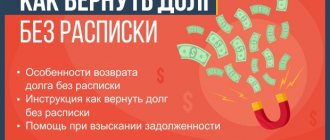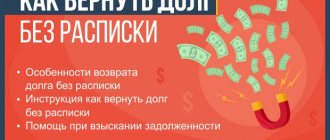Writing off money from accounts, deposits and bank cards is the fastest way to ensure debt collection. The bailiff will quickly receive information about all accounts, cards and Russian electronic wallets of the debtor.
Guided by the resolution received from the FSSP, the bank will begin to write off funds from the debtor’s accounts in favor of the bailiff service. If there is not enough money to completely cover the debt, the account will be blocked for expense transactions, including cash withdrawals.
As funds are credited to the seized card, they will be written off according to the bailiff's order. We will tell you in the article how to remove a seizure from a card, and under what conditions this is even possible.
Seizure of property: what is it?
Seizure of property is a method used by bailiffs to fulfill the requirements contained in the executive document.
Important!
An arrest can be made even during the time allotted for voluntary execution.
Everything related to the seizure of property is regulated by Federal Law FZ-229 “On Enforcement Proceedings”. In this case, special attention should be paid to Art. 80, since it specifies cases in which property belonging to the debtor may be seized by bailiffs.
Such cases include:
- the need to ensure the safety of items (for example, if the bailiff has reason to believe that some items may be hidden)
- execution of a judicial act containing demands for full or partial confiscation of property
- execution of a court order, which directly states the need to seize the property of an individual
The main condition without which an arrest is impossible is the presence of open enforcement proceedings.
Where to contact the debtor
If there are reasons to unblock, we recommend taking the initiative. An application to cancel the blocking can be submitted in person, by letter, or through online services. It depends on the authority you are applying to and the reasons for filing the application. Below we will tell you who should remove the arrest from the card, after what time you can manage your money.
To the bank
The bank complies with the order of the bailiff or the court to block the account and write off money. It makes no sense to contact the bank to lift the arrest until the relevant document is drawn up by a FSSP specialist.
Through the bank, you can only achieve the return of erroneously withheld funds if the violation was committed by the manager or cashier. Also, sometimes problems arise with blocking accounts of namesakes. Bank specialists will help you understand the problem and notify the FSSP or the creditor about the coincidence of your full name and other data.
In the FSSP
To remove the blocking or save income that cannot be written off, an application is submitted to the FSSP. You can go in person to the FSSP department, or send an application by mail. You can also remove the arrest from your card online if you submit an application through the government services service. The applicant must attach documents giving the right to unblock.
— 23 KB
If the bank receives income that is prohibited from being written off, the following must be submitted to the FSSP:
- a certificate from the Pension Fund regarding the payment of a survivor's pension;
- documents from the Pension Fund or social authorities. protection for payment of child benefits;
- a certificate from the employer regarding the payment of one-time financial assistance (upon the birth of a child, upon the death of a family member, etc.);
- judicial act on alimony payments;
- other documents that show the intended purpose of the income.
After verification, the FSSP will revoke the document or send clarifications on the procedure for applying restrictions. It will indicate how to withdraw money credited to the card, what the bank should do with the rest of the proceeds.
How long does it take for a bank card to be frozen?
- When the debt is repaid, the bank notifies the bailiff within one day.
- If the bailiff lifts the block, the bank is obliged to lift the block within 3 days.
The bailiff himself is obliged to make a decision on the debtor’s appeal within a day.
To court
How to remove a seizure from a card through court? This can be done by filing a complaint against the decisions or actions of the bailiff or bank employees.
There is no universal advice on when to go to court. But if the FSSP employee does not react in any way to your requests, although the debt has long been closed, or you receive income on your card that is not subject to withholding, then only the court will help you.
How quickly does a judge consider such issues?
If a complaint is filed against a decision, inaction or action of a representative of the FSSP, it will be considered within 10 days. For some violations, an administrative claim must be filed, which the courts will consider within a month.
Consult our experts if you have any questions about unlocking cards. We will not only explain the rules of law, but also tell you how to get rid of debts and how to find a way out of a difficult financial situation.
What property will the bailiffs seize?
First of all, bailiffs are interested in objects with high liquidity. This means that they can be quickly sold and money received, which will then be used to pay off debts to the creditor. Such objects include cars and other vehicles, residential and non-residential real estate. Accounts and cash are also seized, and in some cases, precious metals and products.
Such situations are rare, so we have collected practical ways to avoid paying bailiffs.
Fact!
Only property that is proportionate to the debt can be seized. This means that the value of the seized property cannot exceed the amount of the recovery.
What cannot be arrested
However, there is property that cannot be seized and included in the bankruptcy estate, regardless of the nature and size of the debt. The list of this property is determined by Art. 446 Code of Civil Procedure of the Russian Federation:
- the only housing
- the land on which it is located
- household items (furniture, refrigerator, washing machine and others)
- things intended for personal use
- products
- animals, if their maintenance is not related to profit-making or business activities
- items, including means of transportation, necessary for the debtor due to disability
- items used for professional activities (for example, musical instruments), provided that their cost does not exceed 10 thousand rubles.
Be careful!
Of course, exceptions to some points are possible. For example, housing and land can be seized if they are encumbered with a mortgage. Items intended for individual use are also confiscated in the case of luxury goods. These include jewelry with precious or semi-precious stones, items made from natural valuable fur, antique items and others.
How an arrest occurs: main stages
The seizure of property by bailiffs takes place at the place where the debtor lives. Please note that two witnesses are mandatory participants in the procedure. At the same time, the presence of the borrower is not strictly necessary, so the arrest can take place even in his absence. The main thing is that the debtor is properly notified.
The seizure includes an inventory of property, its seizure or transfer for storage, as well as an assessment before subsequent sale. Let's look at each of these stages in more detail:
Inventory of property
On average, this process takes from 2 to 6 hours. The inventory is drawn up in the form of a written act, all those present sign. Copies of the document are sent to all parties to the proceedings, including creditors.
The act containing the inventory of property indicates:
- Full name of the debtor and witnesses
- Full name of the bailiff performing the actions
- The name of each item of property and signs allowing it to be identified
- Approximate cost of items included in the inventory
- Full name and residential address of the citizen receiving seized items for safekeeping, or legal address of the organization performing storage
- Notes from persons present during the arrest (for example, the debtor or invited witnesses)
- Notes on the seizure of property and that the person storing the seized items is responsible for them
Lawyer's comment:
“We are often approached by citizens who have decided to file bankruptcy already during enforcement proceedings. The fact is that many bailiffs describe property subject to seizure according to the principle “what I see is what I list.” They brush aside all reasonable arguments of the debtor, and it is not surprising that people are simply afraid to be left without any property - movable and immovable. They understand that the only chance to protect themselves and their family is bankruptcy.”
Kopyrina Anzhelika Vladimirovna
Head of Bankruptcy Litigation Division
Withdrawal and transfer for storage
Real estate (private houses, plots of any size, non-residential properties, etc.), which are seized, comes into the custody of the debtor or members of his family. In rare cases, security is provided by a person with whom the FSSP unit has entered into an agreement.
Movable property (vehicles, expensive equipment, etc.), which is seized, is placed in the custody of the debtor, one of his family members or the claimant. As in the previous case, things can be transferred to a special person for storage. In some cases, documents confirming the debtor’s property rights are stored in the FSSP.
Valuation of property before sale
The assessment of seized property is the responsibility of the bailiff. In doing so, he is guided by his own experience and market prices in effect at the time of seizure of the property. There are often situations when bailiffs deliberately lower the price of things in order to quickly sell them, pay off debts and close the proceedings.
Important!
If the debtor notices this and does not agree with the way the property was assessed, he has the right to appeal its results in court. The period for appeal is limited to 10 days from the date of assessment.
However, there are cases when the assessment is carried out not by the bailiff, but by the appraiser. This applies to the following property:
- any real estate
- a number of securities
- property rights
- jewelry
- items that have historical value
- things whose value exceeds 30,000 rubles according to the approximate estimate of the bailiff
Responsibility
According to Art. 312 of the Criminal Code of the Russian Federation for embezzlement, alienation, concealment or illegal transfer of property that has been subject to inventory or seizure, committed by the person to whom these things are entrusted, as well as by employees of a credit institution for banking operations with money (deposits) that have been seized, a fine of up to 80 thousand . rub. or in the amount of wages or other income of the convicted person for a period of up to six months, or by compulsory work for a period of 180 to 240 hours, or by arrest for a period of three to six months, or by imprisonment for a term of up to two years.
What do bailiffs do with seized property?
Property that has been seized is subject to sale at auction . An exception is real estate and items costing more than 500,000 rubles. They are also sold at auctions, which are held in the form of an auction. Additionally, the law provides for the possibility of transferring seized property into state ownership. This applies to items that are seized under a judicial forfeiture order. Then such items are used by government agencies or organizations.
On a note!
The money received from the sale of seized property goes to the deposit account of the FSSP unit in which enforcement proceedings are opened. And already the bailiffs transfer them to the collectors in order to pay off the debts.
On average, the sale of property lasts from 2 to 12 months. The procedure time increases if the debtor appeals the actions of the bailiffs. There are also situations when third parties send a petition to exclude property from seizure (for example, if it does not belong to the debtor, but to his parents, grandchildren or friends).
When the bailiff has the right to lift the arrest, but is not obliged
There are situations when the bailiff is not obliged to cancel the blocking of the card, but can do this on his own initiative or at the request of the debtor.
Seizure is only one of the interim measures, and the debtor can ask the bailiff to give permission to use the account. In return, registration of vehicles or real estate will be prohibited. Also, the FSSP can revoke the seizure of the account if the write-off began with the debtor’s salary or pension.
How to remove a seizure from a salary card if the money is written off in the accounting department?
You need to submit a statement to the bailiff that the salary is transferred to the account after deduction.
The FSSP employee is obliged to ensure that no more than 50% of income is written off (for alimony 70%). However, when sending documents simultaneously to the place of work, it is difficult to control this: the employer will first write off half of the debtor’s salary, send the rest to the bank, and the bank will keep half of this credit. As a result, the person will receive only 25% of his salary or pension. To avoid double deduction, you need to ask to remove the seizure from your bank account.







